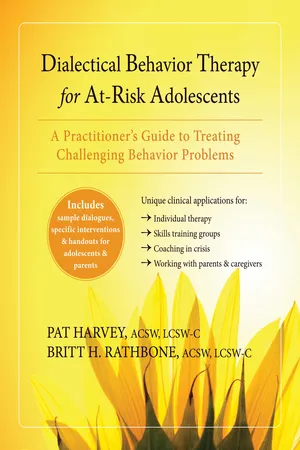
- English
- PDF
- Available on iOS & Android
About This Book
Adolescents are more likely than any other age groups to engage in behaviors that contribute to injuries, violence, unintended pregnancies, sexually transmitted diseases, and reckless alcohol, tobacco, and drug use. At-risk adolescents may also exhibit signs of moodiness, aggression, and even self-injury, and these behaviors often cause parents, teachers, and clinicians to become extremely frustrated. Adolescents themselves may even believe that change is impossible.Drawing on proven-effective dialectical behavior therapy (DBT), Dialectical Behavior Therapy for At-Risk Adolescents is the first reader-friendly and easily accessible DBT book specifically targeted to mental health professionals treating adolescents who may be dangerous to themselves or others. If you work with adolescents who exhibit at-risk behavior, you know how important it is to take immediate action. However, you may also have trouble "breaking through" the barrier that these young people can build around themselves. This book can help.The DBT skills outlined in this book are evidence-based, and have been clinically proven to help build emotion regulation skills, which are useful for all age groups, though perhaps especially for the millions of at-risk adolescents experiencing depression, anxiety, anger, and the myriad behaviors that can result from these emotions. This book also includes practical handouts and exercises that can be used in individual therapy sessions, skills training groups, school settings, and when working with parents and caregivers.Adolescents stand at the precipice of the future, and the decisions they make now can have life-long impacts. By showing them how to manage their emotions and deal with the stresses that are common in day-to-day life, you are arming them with the tools they will need to succeed and thrive.
Frequently asked questions
Information
Table of contents
- Introduction
- Acknowledgments
- Part 1
- The Challenge of Adolescence and the Benefits of DBT
- Chapter 1
- Chapter 2
- Part 2
- DBT Treatment for Adolescents: An Overview of DBT Modalities
- Chapter 3
- Chapter 4
- CHAPTER 5
- Chapter 6
- PART 3
- DBT Treatment for Specific Behavioral Problems in Adolescents
- Chapter 7
- Chapter 8
- Chapter 9
- Chapter 10
- Chapter 11
- Part 4
- Practitioners and DBT
- Chapter 12